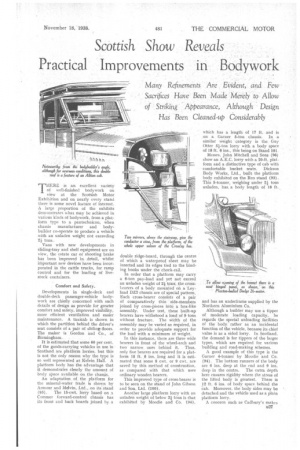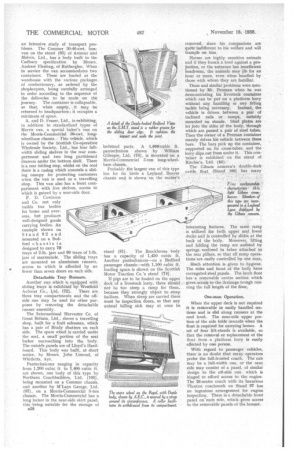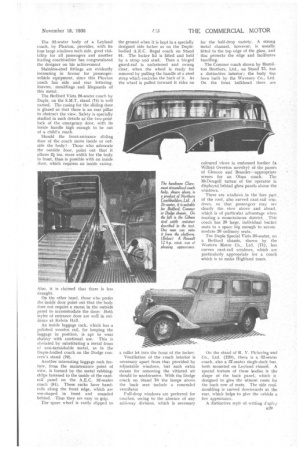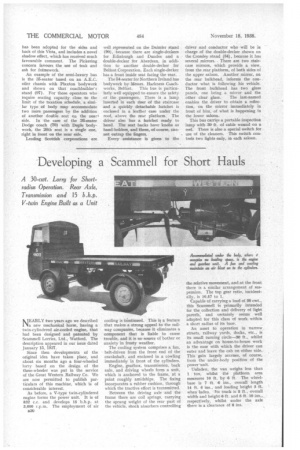Swttish Show Reveals
Page 63

Page 64

Page 65

Page 66

If you've noticed an error in this article please click here to report it so we can fix it.
Practical Improvements in Bodywork
Many Refinements Are Evident, and Few Sacrifices Have Been Made Merely to Allow of Striking Appearance, Although Design Has Been Cleaned-up Considerably THERE is art excellent variety of well-finished bodywork on view at the Scottish Motor Exhibition and on nearly every stand there is some novel feature of interest. A large proportion of the exhibits demonstrates what may be achieved in various kinds of bodywork, from a platform type to a pantechnicon, when chassis manufacturer and bodybuilder co-operate to produce a vehicle with an unladen weight not exceeding 2/ tons.
Vans with new developments in sliding-tray and shelf equipment are on view, the estate car or shooting brake has been improved in detail, whilst important new devices have been incorporated in the cattle trucks, for ramp control and for the loading of livestock containers.
Comfort and Safety.
Developments in single-deck and double-deck passenger-vehicle bodywork are chiefly concerned with such details of design as provide for greater comfort and safety, improved visibility, more efficient ventilation and easier maintenance. A taxicab is shown in which the partition behind the driver's seat consists of a pair of sliding.. doors. The maker is Gordon and Co., of Birmingharn.
It is estimated that some 60 per cent. of the goods-carrying vehicles in use in Scotland are platform lorries, but this is not the only reason why the type is so well represented at Kelvin Hall. A platform body has the advantage that it demonstrates clearly the amount of body space available on the chasiis.
An adaptation of the platform for the mineral-water trade is shown b7„, Armour and Melvin, Ltd., on its stand
(95). The 15-cwt. lorry based on a Commer forward-control chassis has its front and back boards joined by a double ridge-board, through the centre of which a waterproof sheet may be inserted and its edges tied to the binding hooks under the chock-rail.
In order that a platform may carry a 6-ton pay-load and yet not exceed an unladen weight of 2.4 tons, the crosahearers of a body mounted oh a Leyland DZ3 chassis are of special pattern. Each cross-bearer consists of a pair of comparatively thin side-members joined by cross-pieces into a box-like assembly. Under test, these built-up bearers have withstood a load of 9 tons without fracture. The width of the assembly may be varied as required, in order to provide adequate support for the load with a minimum of weight.
In this instance, there are three wide bearers in front of the wheel-arch and two narrow ones behind it. Thus, only five bearers are required for a platform 15 ft. 6 ins. long and It is estimated that some 8 cwt. or 9 cwt. are saved by this method of construction, as compared with that which uses ordinary wooden bearers.
This improved type of cross-bearer is to be seen on the stand of John Gibson and Son, Ltd. (100).
Another large platform lorry with an unladen weight of below 2/ tons is that exhibited by Moodie and Co. (94), and has an underfrarne supplied by the Northern Aluminium Co..
Although a builder may use a tipper of moderate loading capacity, he regards the special unloading facilities of the body rather as an incidental function of the vehicle, because its chief value is as a sided lorry. In Scotland, the demand is for tippers of the larger types, which are required for various building and roacl-making schemes.
A good example of this type is the Garner 4-tonner by Moodie and Co. (94). The bottom runners of the body are 6 ins, deep at the end and 9 ins. deep in the centre. The extra depth here ensures rigidity where the stress of the lifted body is greatest. There is 12 ft. 6 ins, of body space behind the cab. Moreover, the body sides may be detached and the vehicle used as a plain platform lorry.
A concern such as Cadbury's makes 1327 an intensive study of transport problems. The Commer 30-40-cwt. boxvan on the stand (95) of Armour and Melvin, Ltd., has a body built to the Cadbury specification by Messrs. Andrew Fleming, of Rutherglen. When in service the van accommodates two containers. These are loaded at the warehouse with the various packages of confectionery, as ordered by the shopkeepers, being carefully arranged in order according to the sequence of the deliveries to be made on the journey. The container is collapsable, so that, when empty,. it may be retnmed to headquarters ; it occupies a minimum of space.
A. and D. Fraser, Ltd., is exhibiting, in addition to standardized types of Morris van, a special baker's van on the Morris-Commercial 30-cwt. longwheelbase chassis. This vehicle, which is owned by the Scottish Co-operative Wholesale Society, Ltd., has four lull width sliding shelves in the rear compartment and two long partitioned drawers under the bottom shelf. There is a rear folding step, whilst on the roof there is a casing which conceals a sliding canopy for protecting customers when the van is used as a travelling shop. This van also has a front compartment with five shelves, access to which is gained by a near-side door.
F. D. Cowieson and Co. not only builds bus bodies for home and overseas, but produces well-designed goods carrying bodies. An example shown on Stand 92 and mounted on a Bedford chassis is designed to carry 70 trays of 2-1b. jars and 90 trays of 1-1b. jars of marmalade. The sliding trays are mounted on aluminium runners, access to which is afforded by no fewer than seven doors on each side.
Detachable Tray Runners. Another van which is equipped with sliding trays is exhibited by Westfield Autocar Co.,. Ltd. (72). There are three tray compartments and the offside one may be used for other purposes by removing the detachable runner assembly.
The International Harvester Co. of Great Britain, Ltd., shows a travelling shop, built for a fruit salesman, which has a pair of Brady shutters on each side. The spare wheel is carried under the seat, a small portion of the seat locker encroaching into the body. The outside panels are of Iloyd's Hardboard. This body was built, at short notice, by Messrs. John Limond, of Whitletts, Ayr.
Pantechnicons ranging in capacity from 1,200 cubic ft. to 1,400 cubic ft. are shown, one body of this type by Northern Coachbuilders, Ltd. (105), being mounted on a Commer chassis, and another by M'Lays Garage, Ltd. (87), on a, Morris-Commercial 5-ton chassis. The Morris-Commercial has a long locker in the near-side skirt panel, this being suitable for the storage of
B28
bedstead parts. A 1,000-cubic ft. pantechnicon shown by William Gillespie, Ltd. (76), is mounted on a Morris-Commercial 3-ton long-wheelbase chassis.
Probably the largest van of this type has for its basis a Leyland Beaver chassis and is shown on the -maker's stand (81). The Brockhouse body has a capacity of 1,450 cubic ft. Another pantechnicon—on a Bedford passenger chassis—with 1,100 cubic ft. loading space is shown on the Scottish Motor Traction Co.'s stand (74) If pigs are to be loaded on the upper deck of a livestock lorry, there should not be too steep a ramp for them. because they strongly object to steep inclines. When sheep are carried there must be inspection doors, so that any animal falling sick may at once be removed, since his companions are quite' indifferent to his welfare and will trample on him.
Horses are highly sensitive animals and if they knock a hoof against a projection, or the entrance has insufficient headroom, the animals may jib for an hour or more, even when handled by those with whom they are familiar.
These and similar problems were mentioned by Mr. Penman when he was demonstrating his livestock container which can be put on a platform lorry without any handling or any lifting tackle being necessary. Instead, the vehicle is driven between a pair of inclined rails or ramps, suitably mounted on stands. Steel plates are let „into the sides of the body, through which are passed a pair of steel tubes. Then the owner of a Penman container merely drives his vehicle between these bars. The bars pick up the container, supported on its cross-tubes, and the lorry slips out from under it. This container is exhibited on the stand of Ritchie's, Ltd. (85).
The Gibson concern's double-deck cattle float (Stand 100) has many interesting features. The same ramp is utilized for both upper and lower decks and is controlled by slides at the back of the body. Moreover, lifting and folding the ramp are assisted by springs enclosed in tubes attached to the rear pillars, so that all ramp operations are easily controlled by one man.
Much attention is given to hygiene. The sides and front of the body have corrugated steel panels. The larch floor has a removable centre section which gives access to the drainage trough running the full length of the floor.
One-man Operation.
When the upper deck is not required it is removable in easily handled sections and is slid along runners at the roof level. The near-side upper portion of the side folds inwards when the float is required for carrying horses. A set of four lift-stands is available, so that the removal or replacement of the float from a platform lorry is easily effected by one person.
With regard to passenger vehicles, there is no doubt that many operators prefer the full-fronted coach. The cab may be a full-width one, or the near side may consist of a panel, of similar design to the off-side one, which is hinged to afford access to the engine. The 26-seater coach with its luxurious Plaxton coachwork on Stand 97 has an ingenious arrangement for engine inspection. There is a detachable front panel on`each side, which gives access to the removable panels of the bonnet. The 32-seater body of a Leyland coach, by Plaxton, provides, with its four large windows each side, good visibility for all passengers and another leading coachbuilder has congratulated the designer on his achievement Stainless-steel fittings are evidently increasing in favour for passengervehicle equipment, since this Plaxton coach has side and rear lettering, louvres, mouldings and lifeguards of this metal.
The Bedford Vista 20-seater coach by Duple, on the S.M.T, stand (74) is well named. The casing for the sliding door is glared so that there is no rear pillar to obstruct the view. Safety is specially studied in such details as' the two-poinf lock of the emergency door, with its inside handle high enough to be out of a chilcrs reach.
Should the front-entrance sliding door of the coach move inside or outside the 'body? Those who advocate the outside door, point out that it allows 21ins, more width for the body in front, than is possible with an inside door, which requires an inside casing.
Also, it is claimed that there is less draught.
On the other hand, those who prefer the inside door point out that the body does not require a recess in the outside panel to accommodate the door: Both styles of entrance door are well in evidence at Kelvin Hall.
An inside luggage rack, which has .a polished wooden rail, for keeping the luggage in position, is apt to wear shabby with continual use. This is obviated by substituting a metal front of non-tarnishable metal, as in the Duple-bodied coach on the Dodge concern's stand (70).
Another interesting luggage rack feature, from the maintenance point of view, is formed by the metal rubbingstrips fastened to the inside of the cant. rail panel on the A.E.C. 32-seater coach (91). These racks have handrails along the front edge, which are vee-shaped in front and rounded behind. Thus they are easy to grip.
The spare wheel is easily slipped to the ground when it is kept in a specially designed side locker as on the Duplebodied A.E.C. Regal coach on Stand 91. The locker lid is lifted and held by a strap and stud. Then a hinged guard-rai is unfastened and swung clear, when the wheel is ready for removal by pulling the handle of a steel strap which encircles the back of it. As the wheel is pulled forward it rides on a roller let into the front of the locker.
Ventilation of the coach .interior Ia necessary apart from that pitivided by adjustable windows, brit 'such extra means for removing the vitiated air should he unobtrusive. With the Dodge coach on Stand 70 the lamps above the back seat include a concealed ventilator
Full-drop window are are preferred for coaches, owing to the absence of any mid-way division, which is necessary for the half-drop variety. A strong metal channel, however, is usually fitted to the top edge of the glass, and this• protects the edge and facilitates handling.
The Commer coach shown by Hamilton Brothers, Ltd., on Stand 75, has a distinctive interior; the body has been built by the Waveney Co., Ltd. On the front bulkhead. there are
coloured views in .embossed leather, (a Wilfrid Overton novelty) of the passes of Glencoe and Brander—appropriate scenes for an Oban coach. The McDougall tartan of the' operator in displayed behind glass panels above the
windows, • .
There are windows in the' fore part', of the roof, atso curved cant-rail 'windows, so that passengers may see clearly the, view above and ahead, which is of particular advantage when tording a' mountainous district. :This coach has 20 large, individual bucket seats in a space big enough to accom a-iodate' 26'' ordinary seats.
The Duple Special Vista 20-seater, on a Bedford chassis, shown by the Western Motor Co., Ltd. (71), has. curve° cant-rail windows, which . are particularly appropriate for a coach which is to make Highland tours.
On the stand of -R. Y. Pickering and Co., Ltd. (120), there is a 32-seater coach, also a 37-seater single-deck bus, both mounted on Leyland cha.ssg. A special feature of these loodies is the shape of the back panel, which is designed to give the utmost room for the back row of seats, The side roofmoulding is curved downwards at the rear, which helps to give the vehicle a low appearance.
A distinctive style of writing &sp!Ity. u29
has been adopted for the sides and back of this Vista, and includes a novel shadow effect, which has received much favourable comment. The Pickering concern favours the use of teak and ash for frdmework.
An example of the semi-luxury bus is the 35-seater based on an A.E.C. oiler chassis with Plaxton bodywork and shown on that coachbuilder's stand (97). For those operators who require seating capacity close to the limit of the taxation schedule, a SiMilar type of body may accommodate two more passengers by the addition of another double seat on the near• side. In the case of the 26-seater Dodge coach (70) with Duple bodywork, the 26th seat is a single one, right in front on the near side.
Leading Scottish corporations are well represented on the Daimler stand (90), because there are single-deckers for Edinburgh and Dundee and a double-decker for Aberdeen, in addition to another double-decker for Belfast Corporation. Each single-decker has a front inside seat facing the rear.
The 54-seater for Northern Ireland has bodywork by Messrs. Harkness Coach
works, Belfast. This bus is particularly well equipped to ensure the safety of the passengers. There is a lamp inserted in each riser of the staircase and a quickly detachable hatchet is enclosed in a leather case under the roof, above the rear platform. The driver also has a hatchet ready to hand. The seat backs have knobs as hand-holders, and these, of course, -cannot -entrap the fingers.
Every assistance is given to the driver and conductor who will be in charge of the double-decker shown on the Crossley stand (84), because it has several mirrors. There are two staircase mirrors, which provide a view, from the rear platform, of both sides of the upper saloon. Another mirror, on the rear bulkhead, informs the conductor what is following his vehicle. The front bulkhead has two glass panels, one being a mirror and the other clear glass. The last-named enables the driver to obtain a reflection, on the mirror immediately in front of him, of what is happening in the lower saloon.
This bus carries a portable inspection lamp with 30 ft. of cable wound on a reel. There is also a special switch for use of the cleaners. This switch controls two lights only, in each saloon.






















































































































